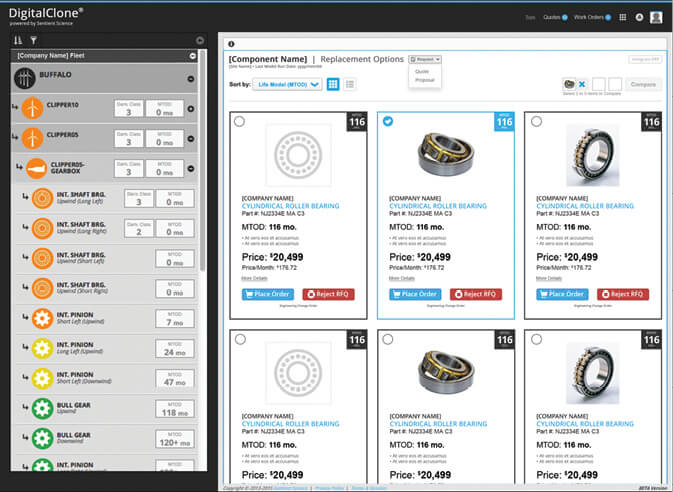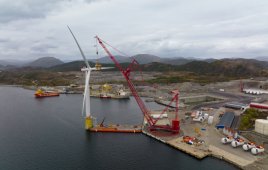Decades of experience with bearing and gear materials have let engineers write accurate predictive maintenance software. Now, it provides guidance on the most durable and appropriate replacement components for wind turbines.
Pedro Berges • MSME PE • Implementations Manager
Aaron Soellinger • Product Marketing Program Manager

Sentient Science computational tribologist Dr. Elon Terrell (in glasses) often goes uptower to assess gearbox problem and confirm prediction from company software, DigitalClone.
Wind power set a record breaking 22% increase in annual installations for 2015. There are at least 281,924 wind turbines generating 432,883 MW of power around the globe. In the United States alone, about 48,500 turbines generate 74,471 MW, enough to power about 20 million American homes, according to the Global Wind Energy Council. In addition, Bloomberg projects that 19 more GW of wind will be installed globally by 2021.
Governments around the world have seen the benefit of renewable energy and offer incentives to spur more installations. U.S. Congress recently passed a five-year, long-term extension with a phase out of the Production Tax Credit. The PTC lets owners of qualified renewable energy facilities receive tax credits for each kilowatt-hour of electricity generated by the facility over a 10-year period.
Today, utilities continue to sign some of the lowest cost, long-term Power Purchase Agreements. That means wind-farm owners and operators must look for innovative ways to lower their Levelized Cost of Energy and remain profitable. That includes investing in predictive maintenance and condition-based monitoring systems to mitigate downtime and O&M costs, which are the largest operating expenditures after the initial capital investment for a wind project.
Problem with big data
All wind turbines use SCADA systems to monitor several operational conditions, such as wind speed and direction, atmosphere pressure, and temperature, and then use the data to analyze the performance and “health” of the turbine. Many also use sensors to detect vibrations that signal a failure. Big data usually
From clean steel to failure

This is how a bearing or gear breaks. What exactly initiates nucleation is a matter of some debate in material circles.
refers to the mountains of information generated by monitored machines, such as wind turbines, along with the effort and algorithms that sort through them to find actionable information. This big data approach to predictive maintenance can pose a challenge for operators to manage without the necessary infrastructure and trained personnel. Statistical and machine learning approaches to predicting the health of a turbine using big data can prove effective when the number of false positives and false negatives are consistently low. However, ineffective systems can do more damage than good by causing costly and unnecessary checks, according to most operators.

Company Implementations Manager Pedro Berges at his workstation where he turns component-failure data into prediction information.
For example, maintenance and service calls are more difficult and expensive in the wind industry than in fossil fuel factories because of the difficulty involved with climbing a 100-m tower to reach the ailing equipment. Once in the nacelle, the technician may have to use a borescope to see inside the gearbox and check for visible cracks. Similar work in offshore wind farms costs significantly more.
Another method: Small data
A better way uses a proprietary, material-science-based computational testing approach to determine the earliest time to detect gearbox failures, so the operator is alerted to make operational and component level changes that will extend the life of that gearbox. The fusion of material science, operational conditions, and computational testing enables the detection of cracks and other failure initiations in bearings before the traditional machine-learning approaches would have detected the flaws. The root cause of most wind-turbine mechanical failures is early fatigue crack initiation, which sensors cannot detect until the failure is imminent. However, if action was taken sooner, the failure could have been prevented soon after damage begins.
Sentient Science has developed this material-science-based, computer-testing method. It is often referred to as the small-data approach. It allows for accurate prognostic health maintenance and, hence, multi-year budgeting. More recently, the material-science approach can differentiate between various bearing suppliers according to expected life and thereby offer life-extension recommendations so assets can achieve optimal life and operational performance in the field.
The bearing is the microprocessor of the machine
Most wind-turbine gearbox mechanical failures originate from bearing damage. To predict these failures, it’s critical to understand the steps a bearing goes through on its way to failure. Those stages are crack initiation, crack propagation, short-crack growth, long-crack growth, and operational failure. Bearing failures may or may not be detectible by sensors and big-data methods. When they are not readily detected and treated, bearing misalignments can cause catastrophic failure of the gearbox. Condition-based monitoring systems only detect the long-crack growth and operational failure, which typically occurs within the last few weeks of the bearing life. In the best circumstances, a site manager barely has enough time to perform predictive maintenance to save the gearbox from primary and secondary failures.
The costs accumulated by gearboxes can grow exponentially when denied proper service and maintenance strategies. Aggregate industry statistics show that a wind-turbine gearbox is replaced every five to seven years at a cost of $200,000 to $300,000 for 1.5-MW systems and approximately $750,000 for 2.5-MW gearboxes. That does not include the cost of the crane, labor, and the loss of revenue from downtime. However, when component damage is predicted early enough, up-tower repairs can limit component replacement costs to between $30,000 and $75,000. Such activity can effectively delay gearbox replacement.

When O&M crews have a choice between two or more components, especially bearings and gears, a BuyOnLife feature provides an evaluation of the components and how they will perform in the client’s turbine.
Life-extension solutions
Sentient’s prognostic approach uses material science to analyze and capture the material microstructure and properties of the bearings, gears, and gearbox under the customer’s operating conditions. This “small data” approach tests components on high-performance computers to predict the failure rates from 0 to 30 years. The company’s DigitalClone Live Software as a Service delivers failure rates in a web portal, which operators can use to build multi-year rolling O&M spending forecasts and plan less costly, preventative-maintenance schedules.
The material-science method applies its knowledge of friction and the effects that it has on the rotating mechanical systems. The DigitalClone Live software simulates how subcomponents interact with each other within a system, such as a gearbox, and the time it takes for critical components to begin crack initiation, propagation, and growth. If a forecasted failure can be prevented, the software will suggest a life-extension solution, such as an operational change, a surface treatment, a component change, or use of a lubrication additive to extend the life of the gearbox.
For example, scientists recently developed a material-science-based predictive model for a 1.5-MW gearbox and studied the impact that a nano and micro-particle based lubricant additive treatment had on the system. It was predicted that with use of the additive, an improvement in the overall bearing life would occur by a factor of 3.3 and overall gear life by a factor of 2.6.
Buy this bearing, not that one
Another small-data solution provides comparative data regarding gearbox or subcomponent choice from different suppliers. Depending upon the operator’s use case, it’s often more economical to reconfigure an existing gearbox with better components than to exchange the gearbox for a new model. Sentient Science software can recommend component changes based on lifing data of competitive components and the lifing impact on the gearbox system. Lifing refers to data or parameters that govern component life. Those responsible for maintenance can effectively extend the life of existing assets to meet their proposed design life and proformas. In some cases, a gearbox life can be extended beyond a 20-year life. This feature is called “Buy on Life” so the operator has lifing impact data along with cost data to make purchasing decisions.
Our company has been aggregating lifing data and failure rates of gearbox assets across the wind market and launched a new product for suppliers at the American Wind Energy Association WINDPOWER 2016 conference last month. The company’s new DigitalClone Live product means suppliers will have visibility into operator demand by understanding which gearbox models will require uptower component replacement or complete change out over the next 18 months. Operators will also have access to various auction mechanisms to engage the supplier community and find the lowest prices for components with the longest life.
In Daniel Yergin’s book, “The Quest,” he writes that the power of reducing friction by just 1% across the major industries can amount to driving as much value in the market as a new source of fuel. Today’s technology helps operators achieve greater than that 1% improvement by extending the life of their existing assets and providing the right data to make better supply chain and inventory decisions. Using this small-data approach, operators will reduce O&M costs, lower energy costs, and improve profitability.
Filed Under: Featured, O&M




